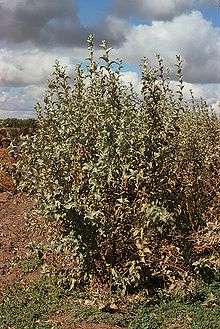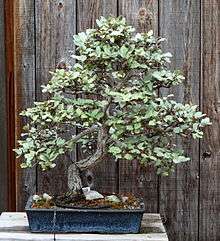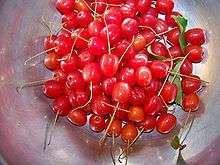Elaeagnus
Elaeagnus /ˌɛliːˈæɡnəs/,[1] silverberry or oleaster, is a genus of about 50–70 species of flowering plants in the family Elaeagnaceae.[2]
| Elaeagnus | |
|---|---|
 | |
| American silverberry (Elaeagnus commutata) | |
| Scientific classification | |
| Kingdom: | Plantae |
| Clade: | Tracheophytes |
| Clade: | Angiosperms |
| Clade: | Eudicots |
| Clade: | Rosids |
| Order: | Rosales |
| Family: | Elaeagnaceae |
| Genus: | Elaeagnus L. |
| Species | |
|
See text | |
 | |
Habitat
The vast majority of the species are native to temperate and subtropical regions of Asia.[2] Elaeagnus triflora extends from Asia south into northeastern Australia, while E. commutata is native to North America, and Elaeagnus philippinensis is native to the Philippines. One of the Asian species, E. angustifolia, may also be native in southeasternmost Europe, though it may instead be an early human introduction there. Also, several Asiatic species of Elaeagnus have become established as introduced species in North America, with some of these species being considered invasive, or even designated as noxious, in portions of the United States.[2][3][4]
Description
Elaeagnus plants are deciduous or evergreen shrubs or small trees.[2] The alternate leaves and the shoots are usually covered with tiny silvery to brownish scales, giving the plants a whitish to grey-brown colour from a distance. The flowers are small, with a four-lobed calyx and no petals; they are often fragrant. The fruit is a fleshy drupe containing a single seed; it is edible in many species. Several species are cultivated for their fruit, including E. angustifolia, E. umbellata, and E. multiflora (gumi). E. umbellata contains the carotenoid lycopene.[5]
Cultivation
Elaeagnus species are widely cultivated for their showy, often variegated, foliage, and numerous cultivars and hybrids have been developed.[6]
The fruit is acid and somewhat astringent.[2] It makes good tarts."[7]

Notable species and hybrids in cultivation include:-
- Elaeagnus angustifolia
- Elaeagnus commutata
- Elaeagnus macrophylla
- Elaeagnus multiflora
- Elaeagnus pungens
- Elaeagnus × reflexa
- Elaeagnus × submacrophylla (syn. E. × ebbingei)
- Elaeagnus umbellata
The hybrid Elaeagnus × submacrophylla[8] and the cultivar 'Gilt Edge'[9] have gained the Royal Horticultural Society's Award of Garden Merit.[10]

Ecology
Elaeagnus species are used as food plants by the larvae of some Lepidoptera species including Coleophora elaeagnisella and the Gothic moths. The thorny shrubs can also provide good nesting sites for birds.
Nitrogen fixation
Many Elaeagnus species harbor nitrogen-fixing organisms in their roots, so are able to grow well in low-nitrogen soils.[2] This ability results in multiple ecological consequences where these Elaeagnus species are present. They can become invasive in many locations where they are established as exotic species. Two species (E. pungens and E. umbellata) are currently rated as category II noxious, invasive species in many world regions[2] and by the Florida Exotic Pest Plant Council.[4]
Selected species
- Elaeagnus angustata (Rehd.) C. Y. Chang (China)
- Elaeagnus angustifolia L. (oleaster, Russian silverberry, or Russian olive; western Asia)
- Elaeagnus argyi Levl. (China)
- Elaeagnus bambusetorum Hand.-Mazz. (China)
- Elaeagnus bockii Diels (China)
- Elaeagnus cinnamomifolia W. K. Hu et H. F. Chow (China)
- Elaeagnus commutata Bernh. (American silverberry or wolf-willow; North America)
- Elaeagnus conferta Roxb. (1820) (southern Asia)
- Elaeagnus courtoisi Belval (China)
- Elaeagnus davidii Franch. (China)
- Elaeagnus delavayi Lecomte (China)
- Elaeagnus difficilis Serv. (China)
- Elaeagnus formosana Nakai (Taiwan)
- Elaeagnus glabra Thunb. (eastern Asia)
- Elaeagnus gonyanthes Benth. (China)
- Elaeagnus griffithii Serv. (China)
- Elaeagnus grijsii Hance (China)
- Elaeagnus guizhouensis C.Y. Chang (China)
- Elaeagnus henryi Warb. (China)
- Elaeagnus jiangxiensis C.Y. Chang (China)
- Elaeagnus jingdonensis C.Y. Chang (China)
- Elaeagnus kanaii Momily. (China)
- Elaeagnus lanceolata Warb. (China)
- Elaeagnus lanpingensis C.Y. Chang (China)
- Elaeagnus latifolia L. (southern Asia)
- Elaeagnus liuzhouensis C.Y. Chang (China)
- Elaeagnus longiloba C.Y. Chang (China)
- Elaeagnus loureirii Champ. (southern China)
- Elaeagnus luoxiangensis C.Y. Chang (China)
- Elaeagnus luxiensis C.Y. Chang (China)
- Elaeagnus macrantha Rehd. (China)
- Elaeagnus macrophylla Thunb. (eastern Asia)
- Elaeagnus magna Rehd. (China)
- Elaeagnus micrantha C.Y. Chang (China)
- Elaeagnus mollis Diels (China)
- Elaeagnus morrisonensis Hayata (Taiwan)
- Elaeagnus multiflora Thunb. (cherry silverberry or gumi; eastern Asia)
- Elaeagnus nanchuanensis C.Y. Chang (China)
- Elaeagnus obovata Li (China)
- Elaeagnus obtusa C.Y. Chang (China)
- Elaeagnus oldhami Maxim. (China)
- Elaeagnus ovata Serv. (China)
- Elaeagnus oxycarpa Schltdl. (China)
- Elaeagnus pallidiflora C.Y. Chang (China)
- Elaeagnus parvifolia Wallich ex Royle (central Asia)
- Elaeagnus pauciflora C.Y. Chang (China)
- Elaeagnus philippinensis Perrott. (lingaro berry; Philippines)
- Elaeagnus pilostyla C.Y. Chang (China)
- Elaeagnus pingnanensis C.Y. Chang (China)
- Elaeagnus pungens Thunb. (silverthorn; Japan)
- Elaeagnus pyriformis Hook.f. (eastern Himalaya)
- Elaeagnus retrostyla C.Y. Chang (China)
- Elaeagnus sarmentosa Rehd. (China)
- Elaeagnus schlechtendalii Serv. (China)
- Elaeagnus stellipila Rehd. (China)
- Elaeagnus taliensis C.Y. Chang (China)
- Elaeagnus thunbergii Serv. (China)
- Elaeagnus tonkinensis Serv. (southeastern Asia)
- Elaeagnus triflora Roxb. (southeastern Asia, northeast Australia)
- Elaeagnus tubiflora C.Y. Chang (China)
- Elaeagnus tutcheri Dunn (southern China).
- Elaeagnus umbellata Thunb. (Japanese silverberry or autumn olive; eastern Asia).
- Elaeagnus viridis Serv. (China)
- Elaeagnus wenshanensis C.Y. Chang (China)
- Elaeagnus wilsonii Li (China)
- Elaeagnus wushanensis C.Y. Chang (China)
- Elaeagnus xichouensis C.Y. Chang (China)
- Elaeagnus xizangensis C.Y. Chang (China)
- Hybrids
- Elaeagnus × submacrophylla (E. macrophylla × E. pungens)
- Elaeagnus × pyramidalis (E. commutata × E. multiflora)
- Elaeagnus × reflexa (E. pungens × E. glabra)
References
- Sunset Western Garden Book. 1995. pp. 606–7. ISBN 978-0-376-03850-0.
- "Elaeagnus umbellata (autumn olive)". CABI. 3 January 2018. Retrieved 8 February 2018.
- "Elaeagnus". County-level distribution maps from the North American Plant Atlas (NAPA). Biota of North America Program (BONAP). 2014.
- "Florida Exotic Pest Plant Council Invasive Plant Lists". Florida Exotic Pest Plant Council. Retrieved 6 February 2012.
- Fordham, Ingrid M.; Clevidence, Beverly A; Wiley, Eugene R.; Zimmerman, Richard H. (2001). "Fruit of autumn olive : A rich source of lycopene". HortScience. 36 (6): 1136–7. ISSN 0018-5345.
- RHS A-Z encyclopedia of garden plants. United Kingdom: Dorling Kindersley. 2008. p. 1136. ISBN 1-4053-3296-4.
- J. H. Maiden (1889). The useful native plants of Australia : Including Tasmania. Turner and Henderson, Sydney.
- "RHS Plantfinder - Elaeagnus × submacrophylla". Retrieved 5 June 2020.
- "Eleagnus × ebbengei 'Gilt Edge'". Royal Horticultural Society. Retrieved 5 June 2020.
- "AGM Plants - Ornamental" (PDF). Royal Horticultural Society. July 2017. p. 35. Retrieved 6 February 2018.
External links
| Wikimedia Commons has media related to Elaeagnus. |